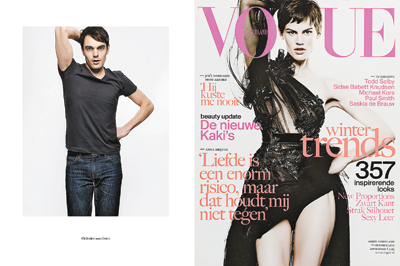
Cao Zhen
caozhen0806@126.com
THERE is no denying the natural beauty of a human’s body. The human body is in itself a classic subject for creative photography.
An exhibition of human body photography presented by nine Dutch artists is being held at He Xiangning Art Museum, adding a new and fascinating chapter to the subject. Titled “The Space Between Us,” the exhibition features works by emerging Dutch artists, Anouk Kruithof, Elza Jo, Jaap Scheeren, Jan Hoek, Koen Hauser, Melanie Bonajo, Paul Kooiker, Stefan Ruitenbeek and Willem Popelier.
Foam, an Amsterdam-based photography museum, is providing the exhibition.
“The ways contemporary artists make use of photography are diverse and mind-freeing. The nine artists all have an interesting take on the representation of the human body. Their exhibits are visually captivating and multi-layered,” said Marcel Feil, a deputy director of Foam and one of the curators of the exhibition.
He said the title “The Space Between Us” means interaction between artists and models or between viewers and models in exploring the value of human body photography.
“The body can be seen as a pure form, as flesh and skin, but at the same time as an object of the artist’s voyeuristic gaze fuelled by latent eroticism, like Kooiker’s ‘Sunday’ series photography,” said Feil.
In Kooiker’s “Sunday” series, a naked model, only wearing a pair of black shoes, lies on a park bench, without showing her face. The model’s skin is pale and distorted, presenting a sharp contrast with the dark background of the park. Her obese body shape and the little black shoes also make a strong visual contrast, giving a twist of eroticism.
“Choosing not to show the model’s faces means there’s no exchange between the model and the artist. It’s one direction. It’s only the male artist looking at the female model’s physical body. So it’s also a question of power. The artist controls the body of the model, but she is not aware of it,” said Feil.
Feil explained that Kooiker explores various aspects of the theme of looking: voyeurism, shame and distance. His work is a continuation of the trope of focusing on the relationship between the artist and the model, the observer and the observed. Kooiker uses his photos to raise questions about a photographer’s reason for looking at things and the motivation behind photographing something.
While in Kooiker’s skin-distorted images there is a different perspective of human body photography, in Kruithof’s works, human bodies can be manipulated. In her “Pixel Stress: Sweat Stress” series, the artist asked people to exercise physically and took photos of the color blurs on their T-shirts created by sweat to catch the human being’s emotional state of exhaustion. Kruithof’s works make images with the human body without showing the human body.
In Ruitenbeek’s works, however, bodies create fantasies. Several naked models are splashed with multiple color paints, like an oil-painting canvas. For Ruitenbeek, painting is only a metaphor for the artistic act and the artists transform human bodies. “The series contain realistic photos, but at the same time, they are abstract art because there’s space between reality and abstract form, between body and abstract image,” explained Feil.
There’s a lot of humor and irony in this exhibition as well. The human body can also be part of a satirical construct mocking gender and social obligations, like Bonajo’s “Furniture Bondage” series. In the photos, naked models are loaded with a dizzying array of mundane household objects. With faces turned away or hidden by hair, the bodies become malleable objects, jammed into the space made by a desk chair, tied up with a phone cord, folded into an aluminum ladder or bent into a wooden shelf unit.
“The photos present an ironic vision of liberating women from the housework. Here, irony in photography not only comments and criticizes a certain topic, but also attracts the attention of spectators,” said Feil.
Irony and playfulness is a way to communicate with the audience. Even serious subjects can be presented at first sight in a lighthearted and playful way.
In Popelier’s “En Vogue” series, the artist uses himself as model to replace female models on fashion magazines. He takes an analytical photographic view on Vogue magazine, but takes away all elements, only focusing on the body. Feil said: “In fashion photography, the human body is very important because it shows the dress; but from Popelier’s experiments, we immediately recognize the photograph as fashion, not only because of the clothes, but also in the way the model looks and poses.”
Feil stressed that art sometimes does not give an answer, but raise questions; therefore, he hopes the exhibition will cast a light on themes and issues of how people construct the notion of physical self through photography. “The exhibition is playful, ironic and utterly diverse. It showcases contemporary Dutch photography, as well as touches upon human complexities,” said Feil.
|

